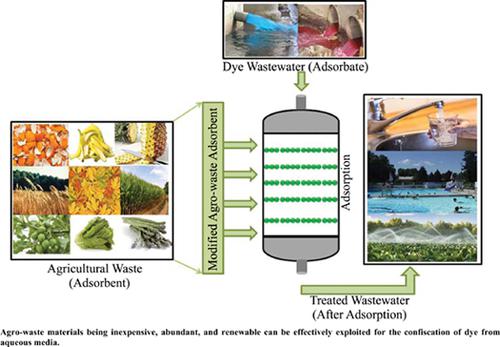Current Analytical Chemistry ( IF 1.7 ) Pub Date : 2021-08-31 , DOI: 10.2174/1573411016666200102114854 Fouzia Mashkoor 1 , Abu Nasar 1

|
Background: The extensive industrialization and unrestricted development of dyeutilizing industries coupled with the shortage of proper effluent treatment methods have increased the water pollution. Disposal of dyes in a natural water system is a severe worldwide concern owing to the harmful effects on the ecosystem. Among the available wastewater treatment methods, adsorption is considered as a promising alternative in the elimination of dyes.
Methods: There are a variety of ways for the modification of agro-waste, such as (i) acid modification (ii) alkali modification, (iii) surfactant modification, and (iv) preparation of activated carbon, etc. Moreover, numerous techniques have been used for the characterization of modified agro-waste, such as, SEM/EDAX, TEM, BET, TGA, and FTIR.
Results: From the literature study, it was observed that the adsorption efficiency of various modified agro-waste is reliant on the nature of the adsorbent materials and different batch parameters, such as initial dye concentration, solution pH, adsorbent dose, and temperature of the system. In this way, these components must be thought about while evaluating the elimination of dye using various agrobased adsorbents.
Conclusion: Modification of agricultural waste usually improved the adsorption capacity of adsorbents due to an escalation in the number of active adsorbing sites, enhancement in the porosity, increase in the surface area, and generation of new functional groups that favor the removal of dye from wastewater. Agro-waste materials being inexpensive, abundant, and renewable can be effectively exploited for the confiscation of dye from aqueous media.
中文翻译:

农业废弃物衍生材料在处理染料污染水体中的环境应用:综述
背景:染料工业的广泛工业化和无限制发展,加上缺乏适当的污水处理方法,加剧了水污染。由于对生态系统的有害影响,在天然水系统中处理染料是一个严重的全球问题。在可用的废水处理方法中,吸附被认为是消除染料的一种有前途的替代方法。
方法:农业废弃物的改性有多种途径,如(i)酸改性(ii)碱改性,(iii)表面活性剂改性,(iv)活性炭制备等。已用于改性农业废弃物的表征,例如 SEM/EDAX、TEM、BET、TGA 和 FTIR。
结果:从文献研究中可以看出,各种改性农业废弃物的吸附效率取决于吸附材料的性质和不同的批次参数,如初始染料浓度、溶液 pH 值、吸附剂剂量和吸附剂的温度。系统。这样,在评估使用各种农用吸附剂去除染料时必须考虑这些成分。
结论:由于活性吸附位点数量的增加、孔隙率的增加、表面积的增加以及有利于去除废水中染料的新官能团的产生,农业废弃物的改性通常会提高吸附剂的吸附能力. 廉价、丰富和可再生的农业废弃物材料可以有效地用于从水性介质中没收染料。











































 京公网安备 11010802027423号
京公网安备 11010802027423号